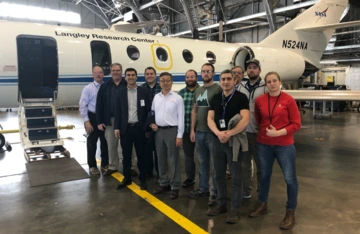Catching Clouds: Understanding Aerosol-Cloud Interactions

It was big news: In fall 2018, NASA awarded $30 million to fund a University of Arizona-led project studying the complex interactions between aerosols and clouds. For Armin Sorooshian, professor of chemical and environmental engineering and the project’s principal investigator, and Xubin Zeng, professor of atmospheric sciences and deputy principal investigator, the grant represents a major milestone in our evolving understanding of aerosol-cloud interactions and their larger impact on climate change. The five-year project kicked off in February 2019, with data analysis and forecasting activities already underway.
The Problem
Scientists know that human activities affect the atmosphere via the emissions of both gases and aerosol particles. While greenhouse gases are widely known for heating the planet, aerosol particles actually exert a net cooling effect. “Particles cool by directly reflecting sunlight back up to space, but they can also indirectly cool the planet owing to their role in seeding cloud droplets where clouds then reflect sunlight back up to space,” Sorooshian says. “Our research project aims to understand the nature and magnitude of the complex interactions between aerosol particles and clouds, with the overarching goal to increase the level of confidence in how humans are impacting the planet’s energy balance and water cycle.”
But aerosols are notoriously difficult to research. Not only are they microscopic in size, but they also have a short lifetime (just a few days) in the atmosphere, and when transported their properties continuously change because of chemical and thermodynamic processes that take place in transit.
Clouds are also incredibly complex. There’s “a wide assortment of feedback processes involved between them and the meteorological environment that they reside in, which makes teasing out an aerosol effect on clouds, and vice versa, very difficult,” Zeng says. The NASA-funded project focuses on warm marine boundary layer clouds, which cover more than 45% of the ocean surface and exert a large net cooling effect. Thus, they are of special interest owing to their pivotal role in unresolved climate change questions.
“The interactions of particles with clouds are especially challenging because they represent a system hard to access from the ground,” Sorooshian says. “Aircraft are needed to get the type of in situ data required to address their interactions with confidence.”
The Plan
Because of the complexity of aerosol-cloud interactions, the project has a heavy emphasis on airborne measurements, though it also requires laboratory work and extensive modeling. Two NASA research aircraft will gather data from above, below and within the clouds over the western North Atlantic. A significant amount of preparation is required in the first year of the project, before the first flights take place in February 2020. The two planned aircraft, based at NASA Langley Research Center (LaRC) in Hampton, Virginia, require modifications to adapt to the instrument payload needed for the flights.
“Since we’ve been studying these topics, advancements have been made in measurement capabilities and modeling efforts, with the synergy of the two being heavily relied on in our current project,” Zeng says. “We are also addressing some fundamental issues for aircraft measurements; e.g., how many hours of aircraft measurements are needed to capture the complex aerosol-cloud interactions under different meteorological conditions.”

University of Arizona professors Xubin Zeng (fifth from left) and Armin Sorooshian (third from left) visited the LaRC in February 2019 to see the two aircraft that will be used for the project.
The Impact
Sorooshian and Zeng say that with the culmination of the joint research flights, an unprecedented data set will be made available to the public for analysis. This lasting legacy of the project will be of tremendous value in advancing scientific understanding of aerosol-cloud interactions, and its impact will be felt for decades to come.
With the data set, the team intends to improve weather and climate model treatments relating to aerosol particles, meteorology and clouds, as well as demonstrate and evaluate advanced remote-sensing instruments and algorithms for current and future satellite missions. Another effect of the project will be extensive outreach to educate both scientists and the public about the topic.
Speaking from the vantage point at the outset of a historic project, Sorooshian and Zeng agree that their role at the University of Arizona uniquely positions them for success. “We were both drawn to the UA owing to its multidisciplinary strength as an institution,” Sorooshian says. “It is hard to find other institutions offering so many diverse programs on one campus such as, but not limited to, law, business, public health, engineering, environmental sciences, social sciences and two medical school campuses. The UA campus is arguably the heartbeat of Tucson and we both have always been drawn to environments like this that value higher education and a pursuit to advance education and higher learning.”
This project is a NASA Earth Venture Suborbital (EVS-3) investigation, funded by NASA’s Earth Science Division and managed through the Earth System Science Pathfinder Program Office. The program funds projects investigating important but not-well-understood aspects of Earth’s systems that also require sustained observations.
